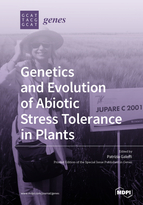Genetics and Evolution of Abiotic Stress Tolerance in Plants
A special issue of Genes (ISSN 2073-4425). This special issue belongs to the section "Plant Genetics and Genomics".
Deadline for manuscript submissions: closed (15 November 2021) | Viewed by 37056
Special Issue Editor
Interests: plant functional genomics; cereal transcriptomics; DREB gene family; plant genetics; abiotic stress tolerance in plant; antibody molecular biology; crop genetic improvement; VRN gene family; QTL related to the abiotic stresses
Special Issues, Collections and Topics in MDPI journals
Special Issue Information
Dear Colleagues,
Now more than ever, understanding the genetics and evolution of the gene mechanisms and the networks of different molecular pathways acting on plant abiotic stress tolerance has an important role in the finding of new solutions and approaches able to contribute to a good equilibrium among human needs, food security, and future strategies for mitigating the effects of global climate changes.
In this context, a major role for science and research is very welcome.
Scientists have the relevant task of increasing our knowledge in the complex area of plant genetics and genomics, the genes responsive to specific abiotic stresses (such as drought, salts, or heat) and their inducible promoters, and various gene expression control and modulation mechanisms, including alternative splicing, micro-RNA interference, post-transcriptional mRNA decay, and post-translational protein degradation. At the same time, evolution has played a key role in the establishment of the current plant molecular traits, so that major insights into the genetic diversity producing different alleles, adaptation, phylogenesis, and evolution of genomes and gene families can be translated and applied as tools for developing new tolerant plant varieties able to satisfy our needs, in terms of food security, protection of the planet, and conservation and recovery of natural resources such as water and soils.
With this Special Issue, I wish to invite the submission of high-quality original research manuscripts or review articles on any topic related to:
“Genetics and Evolution of Abiotic Stress Tolerance in Plants”.
Please submit your research and join in our Special Issue, which will represent an exciting virtual tour through plant molecular responses to the various environmental stresses.
You will find all the necessary information and instructions and a team up to the task at the Genes editorial office.
Dr. Patrizia Galeffi
Guest Editor
Manuscript Submission Information
Manuscripts should be submitted online at www.mdpi.com by registering and logging in to this website. Once you are registered, click here to go to the submission form. Manuscripts can be submitted until the deadline. All submissions that pass pre-check are peer-reviewed. Accepted papers will be published continuously in the journal (as soon as accepted) and will be listed together on the special issue website. Research articles, review articles as well as short communications are invited. For planned papers, a title and short abstract (about 100 words) can be sent to the Editorial Office for announcement on this website.
Submitted manuscripts should not have been published previously, nor be under consideration for publication elsewhere (except conference proceedings papers). All manuscripts are thoroughly refereed through a single-blind peer-review process. A guide for authors and other relevant information for submission of manuscripts is available on the Instructions for Authors page. Genes is an international peer-reviewed open access monthly journal published by MDPI.
Please visit the Instructions for Authors page before submitting a manuscript. The Article Processing Charge (APC) for publication in this open access journal is 2600 CHF (Swiss Francs). Submitted papers should be well formatted and use good English. Authors may use MDPI's English editing service prior to publication or during author revisions.
Keywords
- Abiotic stress tolerance genes
- Drought stress genes
- Transcription factors
- Heat stress genes
- DREB gene family
- AREB gene family
- Myc, Myb gene family
- bZip gene family
- LEA gene family
- Molecular mechanisms of abiotic stress tolerance
- Alternative splicing of abiotic stress tolerance genes
- Genetic diversity of genes involved in abiotic stresses
- Phylogenesis of abiotic stress tolerance genes
- Evolution studies on stress tolerance genes







